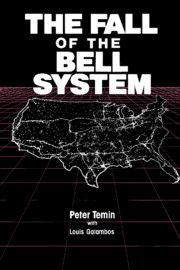Book contents
3 - Action and reaction
Published online by Cambridge University Press: 06 January 2010
Summary
John deButts and “the decision to decide”
AT&T's board of directors had opted for charismatic leadership; John deButts would impose his authority on the sprawling Bell System and give it purpose. He would do so by drawing on the traditional conception of the Bell System rather than by articulating a new one. He would lead the company out of its early 1970s doldrums by energizing its management, by reasserting the role of 195 Broadway in the Bell System's decision-making process, and by inspiring the System's many employees to believe again that the corporation's familiar goals – the objectives Vail had given it – were laudable and achievable. On the other hand, deButts would try to launch the complex process of adapting the Bell System to the changing conditions it faced. He would introduce elements that in time would alter the Bell System's fundamental strategy. But the main thrust of his approach to both company strategy and public policy was conservative. As he reaffirmed the traditional culture and made the existing System run more efficiently, he would actually be making it more difficult for his innovations within the firm to take hold. In that sense, he would be trapped by his own finest achievements.
On April 1, 1972, deButts took charge of a Bell System in deep trouble. The service crises in New York and other cities had shaken the Bell System's self-image as a flawless service organization and tarnished its reputation. Earnings had stopped growing. The regulatory decisions of the previous half-decade had opened up parts of the network – as yet, still small parts-to competition.
- Type
- Chapter
- Information
- The Fall of the Bell SystemA Study in Prices and Politics, pp. 70 - 112Publisher: Cambridge University PressPrint publication year: 1987
- 1
- Cited by



